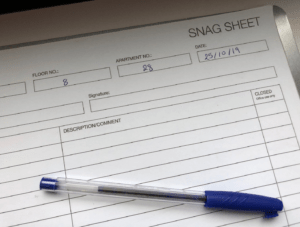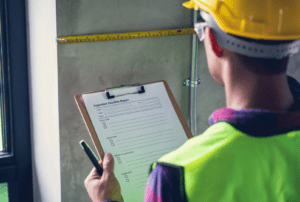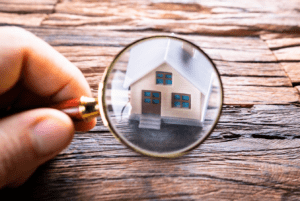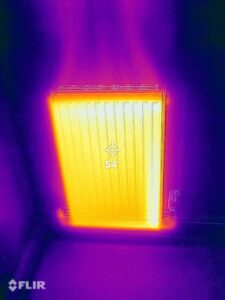
Snagging Inspections: Pro vs. DIY for New Home Quality
Protecting Your Investment – The Importance of a Snagging Inspection Buying a newly built home is an exciting milestone, but it’s crucial to ensure your investment is sound. Snagging inspections
Latest News

As global concerns over climate change continue to escalate, the construction industry is under increasing pressure to adopt sustainable practices. Energy efficiency has emerged as a critical focus area, driven by the need to reduce carbon emissions and promote environmental sustainability. The concept of energy efficiency in buildings encompasses the use of design, materials, and systems that minimise energy consumption while maintaining optimal performance.
One crucial element in achieving energy-efficient buildings is the implementation of thorough inspections. New build inspections ensure that new constructions meet stringent energy efficiency standards and regulations. These inspections play a vital role in identifying areas for improvement, ensuring compliance, and ultimately contributing to the creation of environmentally friendly and economically viable structures.
Energy efficiency is paramount in the construction industry for several reasons:
New build inspections are systematic evaluations conducted during and after the construction of a building. These inspections are carried out by authorised professionals, such as energy assessors, building control officers, or certified inspectors, to ensure compliance with energy efficiency standards and regulations.
The primary goals of new build inspections include:
Through these inspections, potential issues can be identified and addressed early in the construction process, ensuring that the final building is both energy-efficient and sustainable.
New build inspections involve a comprehensive assessment of various aspects of a building to ensure it meets energy efficiency requirements. The process typically includes the following steps:
New build inspections are crucial in achieving energy efficiency for several reasons:
New build inspections are essential in verifying that new constructions comply with a myriad of energy efficiency regulations and standards. Some of the key regulations and standards checked during these inspections include:
During compliance verification, inspectors often encounter common issues that need to be addressed to ensure energy efficiency:
Performance assessments go beyond verifying compliance with regulations; they evaluate the actual energy performance of a building in operation. These assessments involve:
Inspectors often provide recommendations to improve the energy efficiency of new buildings, such as:
Following the recommendations provided by inspectors is crucial for achieving long-term energy efficiency benefits, such as:
Energy-efficient designs, insulation, and systems significantly reduce the amount of energy required to heat, cool, and operate a building. This leads to lower energy bills for occupants and a decreased environmental impact by reducing greenhouse gas emissions associated with energy production.
Energy-efficient buildings often feature improved insulation, effective air sealing, and proper ventilation systems. These measures help maintain consistent indoor temperatures, reduce drafts, prevent moisture-related issues, and enhance indoor air quality. Occupants can enjoy increased comfort and a healthier living or working environment.
Although energy-efficient materials and systems may involve higher upfront costs, they deliver substantial long-term savings. Lower energy consumption translates into reduced utility bills, leading to cost savings over the lifespan of the building. Additionally, energy-efficient buildings tend to have higher market value and appeal to environmentally conscious buyers or tenants.
Energy-efficient buildings play a vital role in reducing carbon emissions and mitigating the impact of climate change. By reducing energy demand and using renewable energy sources, these buildings contribute to a more sustainable future. They align with global environmental goals and help countries meet their emissions reduction targets.
New build inspections play a pivotal role in promoting energy efficiency within the construction industry. Through systematic evaluations, these inspections ensure that new constructions comply with energy efficiency regulations and standards, perform optimally, and offer valuable feedback for improvements. Key points highlighted in this guide include:
New build inspections are essential for ensuring that buildings meet high standards of energy efficiency. They help reduce energy consumption, lower utility costs, and enhance the overall sustainability of the construction industry. By identifying and addressing issues early in the construction process, these inspections contribute to the creation of buildings that are not only environmentally friendly but also economically viable and comfortable for occupants. As the world moves towards a greener future, the role of new build inspections will continue to be integral in achieving sustainable and energy-efficient built environments.
At Home Snagging UK, we are dedicated to ensuring that your property is completed to the highest standards of quality and energy efficiency. Our professional snaggers are trained to conduct comprehensive inspections, identify potential issues, and provide actionable recommendations to enhance the performance and efficiency of your new build.
Contact Home Snagging UK today to ensure your new build is completed to the highest standards of quality and energy efficiency. Learn more about our snagging packages here. Follow us on Instagram to stay updated with our latest projects and special offers.
Visit our website for more information and to book your inspection today!

Protecting Your Investment – The Importance of a Snagging Inspection Buying a newly built home is an exciting milestone, but it’s crucial to ensure your investment is sound. Snagging inspections

The Critical Role of Snagging Key Takeaways: Understand what a snagging list is and why it’s crucial for new homeowners. Learn how to identify both major and minor issues within

The Rise of Digital Platforms Welcome to the evolving world of construction snagging, a pivotal phase in the construction industry where the identification and rectification of small issues or ‘snags’

Ensuring Home Expectations Welcome to Home Snagging UK, where we understand that moving into a new build property is an exciting journey filled with anticipation. However, amidst the excitement, it’s

Essential Role of Snagging Lists In the realm of construction and home inspections, snagging lists play a crucial role in ensuring that new builds meet the highest quality and safety

Why You Need a Snagging Company When investing in a new home, ensuring that your property is free from defects is paramount. A snagging company specialises in inspecting new homes
Barnsley
Beverley
Birmingham
Chester
Chesterfield
Coventry
Derby
Dewsbury
Doncaster
Grantham
Grimsby
Huddersfield
Hull
Huntingdon
Leeds
Leicester
Lincoln
Manchester
Mansfield
Newcastle
Nottingham
Peterborough
Rotherham
Scunthorpe
Sheffield
Shrewsbury
Stoke
Telford
Wakefield
Warwick
Wolverhampton
Worksop
York
We’re home snagging specialists with over 20 years of experience snagging new build homes. We identify construction defects, big or small, that your developer may have missed. We are fully qualified surveyors who work with our customers to make sure they get the perfect home.
© Home Snagging UK 2025
Website Maintained By Be My Social